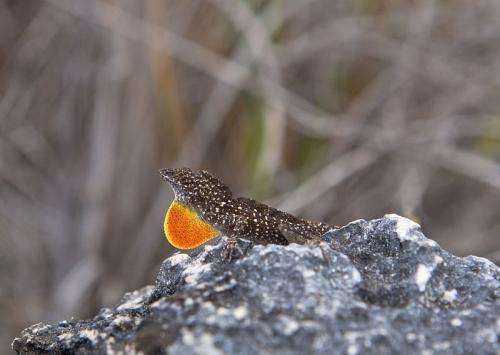May 20, 2014 report
Lizard species found to reduce head bobbing mating ritual when predators are around

(Phys.org) —A team made up of researchers from several universities in the U.S. has found that male brown anoles (Anolis sagrei)—a type of lizard, dramatically reduced its head bobbing mating dance when predators were introduced. In their paper published in Proceedings of the National Academy of Sciences, the researchers describe their field study of the lizards and how it resulted in the discovery that an animal was able to change its mating behavior so quickly.
Male brown anoles, like many other lizards (and other species) engage in a dance of sorts when attempting to attract a mate. It bobs its head in exaggerated movements, puffs up its bright orange dewlap and even does some pushups. In addition to attracting a mate, the dance is believed to also serve as a warning to rivals to stay away. In this new effort, the researchers found that if predators came into the area, the males immediately toned down their moves, hoping apparently, to remain unseen, while attempting to entice a mate.
To find out more about the lizard's mating patterns the team of researchers ventured down to its home in the Bahamas and set about measuring the amount of movement involved in head bobbing with several specimens on several of the islands. Once that was completed, they introduced carnivorous curly-tailed lizards, (Leiocephalus carinatus) onto the islands, which are known to catch and eat brown anoles. After waiting for a period of time to allow the new arrangements to settle, the researchers once again measured the distance the heads of several specimens traveled as they engaged in their head bobbing dance, and found that the distance had decreased dramatically (up to 40 percent). They also noted that the lizards appeared to be more timid as they bobbed, doing so with far less enthusiasm.
The researchers surmise that the reduction in head bobbing was due to a desire to be less noticeable to the newly arrived predators that may be in the area. How the females responded to the feeble mating gestures has yet to be determined, though it's likely they too would prefer to not attract the attention of predators when mating as well.
The researchers note that many cases of animals changing their mating rituals have been observed over the course of several generations in response to predators, but a single species changing its mating habits in its own lifetime has not been seen before.
More information: Predation-associated modulation of movement-based signals by a Bahamian lizard, David S. Steinberg, PNAS, DOI: 10.1073/pnas.1407190111
Abstract
Signaling individuals must effectively capture and hold the attention of intended conspecific receivers while limiting eavesdropping by potential predators. A possible mechanism for achieving this balance is for individuals to modulate the physical properties of their signals or to alter the proportion of time spent signaling, depending upon local levels of predation pressure. We test the hypothesis that prey can alter their visual signaling behavior to decrease conspicuousness and potentially limit predation risk via modulation of signal properties or display rate. To do so, we conducted a manipulative experiment in nature to evaluate the possible effect of predation pressure on the physical properties of movement-based signals and on the proportion of time spent signaling by using a well-understood predator–prey system in the Bahamas, the semiarboreal lizard Anolis sagrei, and one of its main predators, the curly-tailed lizard Leiocephalus carinatus. We find that on islands onto which the predator was introduced, male anoles reduce the maximum amplitude of head-bob displays but not the proportion of time spent signaling, in comparison with control islands lacking the predator. This reduction of amplitude also decreases signal active space, which might alter the reproductive success of signaling individuals. We suggest that future studies of predator–prey interactions consider the risk effects generated by changes in signals or signaling behavior to fully determine the influence of predation pressure on the dynamics of prey populations.
Journal information: Proceedings of the National Academy of Sciences
© 2014 Phys.org


















